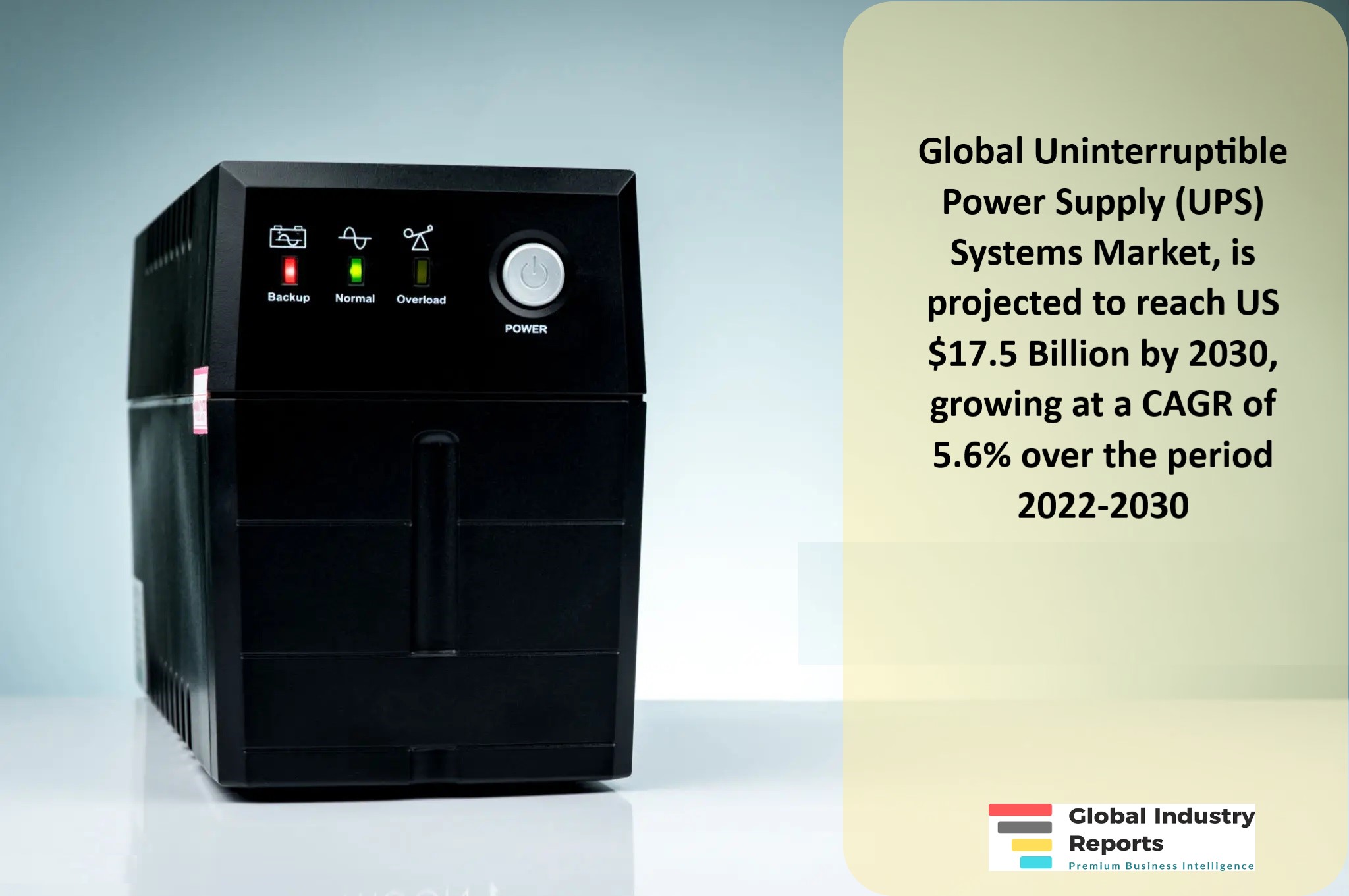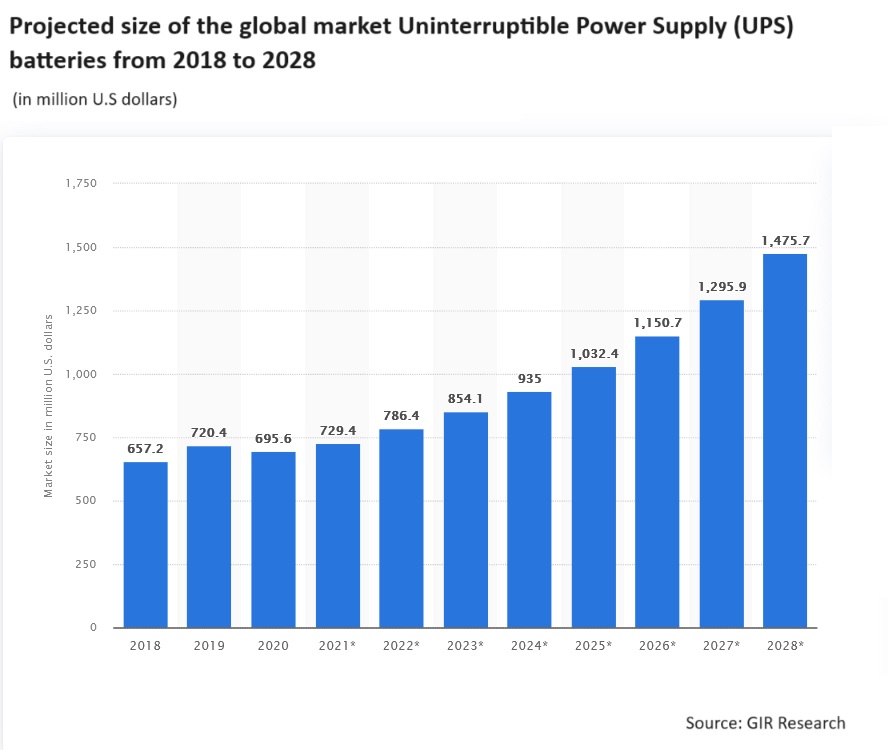Report Overview
- Understand the latest market trends and future growth opportunities for the Uninterruptible Power Supply (UPS) Systems industry globally with research from the Global Industry Reports team of in-country analysts – experts by industry and geographic specialization.
- Key trends are clearly and succinctly summarized alongside the most current research data available. Understand and assess competitive threats and plan corporate strategy with our qualitative analysis, insight, and confident growth projections.
- The report will cover the overall analysis and insights in relation to the size and growth rate of the “Uninterruptible Power Supply (UPS) Systems Market” by various segments at a global and regional level for the 2010-2030 period, with 2010-2022 as historical data, 2023 as a base year, 2024 as an estimated year and 2024-2030 as forecast period.
Description:
- The global market for Uninterruptible Power Supply (UPS) Systems estimated at US$11.8 Billion in the year 2023, is expected to reach US$17.5 Billion by 2030, growing at a CAGR of 5.7% over the analysis period 2023-2030.
- Up to 5 kVA, one of the segments analyzed in the report, is expected to record a 5.6% CAGR and reach US$6.8 Billion by the end of the analysis period. Growth in the 5.1 to 20 kVA segment is estimated at 5.1% CAGR over the analysis period.
- The Uninterruptible Power Supply (UPS) Systems market in the U.S. is estimated at US$2.3 Billion in the year 2023. China, the world`s second largest economy, is forecast to reach a projected market size of US$2.2 Billion by the year 2030 trailing a CAGR of 6.8% over the analysis period 2023-2030. Among the other noteworthy geographic markets are Japan and Canada, each forecast to grow at a CAGR of 3.4% and 4.9% respectively over the analysis period. Within Europe, Germany is forecast to grow at approximately 4.7% CAGR.
MARKET DATA INCLUDED
- Unit Sales, Average Selling Prices, Market Size & Growth Trends
- COVID-19 Impact and Global Economic Slowdown Analysis
- Analysis of US inflation reduction act 2022
- Global competitiveness and key competitor percentage market shares
- Market presence across multiple geographies – Strong/Active/Niche/Trivial
- Online interactive peer-to-peer collaborative bespoke updates
- Market Drivers & Limiters
- Market Forecasts Until 2030, and Historical Data up to 2015
- Recent Mergers & Acquisitions
- Company Profiles and Product Portfolios
- Leading Competitors
The Report Includes:
- The report provides a deep dive into details of the industry including definitions, classifications, and industry chain structure.
- Analysis of key supply-side and demand trends.
- Detailed segmentation of international and local products.
- Historic volume and value sizes, company, and brand market shares.
- Five-year forecasts of market trends and market growth.
- Robust and transparent research methodology conducted in-country.
- Qualitative and quantitative analysis of the market based on segmentation involving both economic as well as non-economic factors.
- Provision of market value (USD Billion) data for each segment and sub-segment.
- Analysis by geography, region, Country, and its states.
- A brief overview of the commercial potential of products, technologies, and applications.
- Company profiles of leading market participants dealing in products category.
- Description of properties and manufacturing processes.
- marketed segments on the basis of type, application, end users, region, and others.
- Discussion of the current state, setbacks, innovations, and future needs of the market.
- Examination of the market by application and by product sizes; utility-scale, medium scale and small-scale.
- Country-specific data and analysis for the United States, Russia, China, Germany, United Kingdom, France, Japan, Israel, Saudi Arabia, South Korea, United Arab Emirates, Canada, Switzerland, Australia, India, Italy, Turkey, Qatar, Sweden, Spain, Belgium, Netherlands, Norway, Singapore, Egypt, Denmark, Austria, Vietnam, Brazil, Argentina, Mexico, South Africa, and others.
- Coverage of historical overview, key industrial development and regulatory framework.
- Analysis of competitive developments, such as contracts & agreements, expansions, new product developments, and mergers & acquisitions in the market.
- A look at the opportunities in the market for stakeholders and provide a competitive landscape of the market leaders.
Reports Scope and Segments:
| Report Attribute | Details |
| Market size value in 2023 | USD 11.8 Billion |
| Revenue forecast in 2030 | USD 17.5 Billion |
| Growth Rate | CAGR of 5.7% from 2023 to 2030 |
| Base year for estimation | 2023 |
| Historical data | 2015 – 2023 |
| Forecast period | 2024 – 2030 |
| Quantitative units | Revenue in USD million and CAGR from 2023 to 2030 |
| Report coverage | Revenue forecast, company ranking, competitive landscape, growth factors, trends, DROT Analysis, Market Dynamics and Challenges, and Strategic Growth Initiatives
COVID-19 Impact, Market Growth Trends, Market Limiters, Competitive Analysis & SWOT for Top Competitors, Mergers & Acquisitions, Company Profiles, Product Portfolios Market Size, Market Shares, Market Forecasts, Market Growth Rates, Units Sold, and Average Selling Prices. |
| Segments covered | Component, Type, Technology, Platform, Application & Region |
| Regional scope | North America; Europe; Asia Pacific; Latin America; Middle East and Africa and rest of the world |
| Country scope | United States, China, Japan, Germany, India, United Kingdom, France, Brazil, Italy, Canada, South Korea, Australia, Russia, Spain, Mexico, Indonesia, Netherlands, Switzerland, Saudi Arabia, Turkey, Taiwan, Poland, Sweden, Belgium, Thailand, Austria, Nigeria, Argentina, United Arab Emirates, Iran, Norway, Israel, Ireland, Malaysia, Denmark, Singapore, Philippines, Pakistan, Finland, Chile, Vietnam, Greece, Czech Republic, Romania, Portugal, Peru, New Zealand, Hungary, Iraq, Bangladesh, Qatar, Kuwait, Ukraine, Egypt, Kazakhstan, Colombia, Angola, Algeria, Morocco, Slovakia, Oman, Puerto Rico, Ethiopia, Sudan, Kenya, Ghana, Dominican Republic, Myanmar, Tanzania, Ecuador, Belarus, Guatemala, Lithuania, Latvia, Sri Lanka, Nepal, Lebanon, Slovenia, Bahrain, Libya and others |
| Key companies profiled | ABB Inc.; Ablerex Electronics Co., Ltd.; AC / DC Electronic Systems Consulting; Active Power, Inc.; Acumentrics, Inc.; Advanced Energy Industries, Inc.; AEG Power Solutions B.V.; Alpha Technologies Services, Inc.; AMETEK, Inc.; APC by Schneider Electric; Aspex Inc.; Baykee New Energy Technology Inc. Co., Ltd; Beijing Dynamic Power Co. Ltd.; Belkin International, Inc.; Benning Power Electronics; Chloride Power Systems & Solutions; Controlled Power Company; Cyber Power Systems Inc.; Dale Power Solutions Ltd.; Delta Electronics Inc.; Delta Power Solutions; EA Elektro-Automatik GmbH & Co. KG; East Group Co., Ltd.; Eaton Corporation; Emerson Electric Co.; Falcon Electric, Inc.; FIDA International (S) Pte., Ltd.; Gamatronic Electronic Industries Ltd.; General Electric (GE); Genus Power; Guangdong Prostar New Energy Technology Co. Ltd.; Hitachi Ltd; Huawei Technologies Co., Ltd.; Jiangsu Meibaijia Electrical Manufacturing Co., Ltd.; JONCHAN Electrical Science & Technology Co.ltd; KACO new energy GmbH; Kehua Tech; KELONG; Kohler Power Systems; Kraus & Naimer GmbH; Kstar New Energy; Legrand; Liebert Corporation; Luminous Power Technologies; Microtek; Minuteman Power Technologies; Mitsubishi Electric Corporation; Piller Power Systems Inc.; Riello UPS; S&C Electric Company; SANTAK; Schneider Electric; Sendon International Ltd.; Shenzhen Jeidar Electronics Co. Ltd; Socomec; STMicroelectronics; Toshiba Corporation; Toshiba Mitsubishi-Electric Industrial Systems Corporation (TMEIC); Tripp Lite; Vertiv Co.; Xiamen Kehua Hengsheng Co. Ltd.; Zebronics; Zhongshan HongBao Electric Co. Ltd. and others |
| Customization scope | Free report customization (equivalent up to 20 analyst’s working days) with purchase. Addition or alteration to country, regional & segment scope. |
| Report Format | PDF, PPT, Excel & Online User Account |
Uninterruptible power supply (ups) systems market report segmented by:
Uninterruptible power supply (ups) systems market based on the component:
* Solution
- 50 kVA and Below
- 51-100 kVA
- 101-250 kVA
- 251-500 kVA
- 501 kVA and Above
* Services
- Training, education, and consulting
- Integration and Implementation
- Support and Maintenance
Uninterruptible power supply (ups) systems market by product type:
- Off-Line/Standby
- Line-Interactive
- Online/Double-Conversion
Uninterruptible power supply (ups) systems market based on organization size:
- Large Enterprises
- Small and Medium-sized Enterprises
Uninterruptible power supply (ups) systems market based on verticals:
- BFSI
- Cloud Service, Data Centers, and Colocation Providers
- Telecom
- Manufacturing
- Healthcare
- Energy and Utilities
- Government and Public Sector
- Others* (include education and retail, industrial, marine)
Uninterruptible power supply (ups) systems market based on regions:
- North America
- Europe
- Asia Pacific
- South America
- Middle East & Africa
- Oceania
- Rest of the world
Companies covered in Uninterruptible power supply (ups) systems market Report:
| ABB Inc. | Huawei Technologies Co., Ltd. |
| Ablerex Electronics Co., Ltd. | Jiangsu Meibaijia Electrical Manufacturing Co. |
| AC / DC Electronic Systems Consulting | JONCHAN Electrical Science & Technology Co. |
| Active Power, Inc. | KACO new energy GmbH |
| Acumentrics, Inc. | Kehua Tech |
| Advanced Energy Industries, Inc. | KELONG |
| AEG Power Solutions B.V. | Kohler Power Systems |
| Alpha Technologies Services, Inc. | Kraus & Naimer GmbH |
| AMETEK, Inc. | Kstar New Energy |
| APC by Schneider Electric | Legrand |
| Aspex Inc. | Liebert Corporation |
| Baykee New Energy Technology Inc. | Luminous Power Technologies |
| Beijing Dynamic Power Co. Ltd. | Microtek |
| Belkin International, Inc. | Minuteman Power Technologies |
| Benning Power Electronics | Mitsubishi Electric Corporation |
| Chloride Power Systems & Solutions | Piller Power Systems Inc. |
| Controlled Power Company | Riello UPS |
| Cyber Power Systems Inc. | S&C Electric Company |
| Dale Power Solutions Ltd. | SANTAK |
| Delta Electronics Inc. | Schneider Electric |
| Delta Power Solutions | Sendon International Ltd. |
| EA Elektro-Automatik GmbH & Co. | Shenzhen Jeidar Electronics Co. Ltd |
| East Group Co., Ltd. | Socomec |
| Eaton Corporation | STMicroelectronics |
| Emerson Electric Co. | Toshiba Corporation |
| Falcon Electric, Inc. | Toshiba Mitsubishi-Electric Industrial Systems Corporation (TMEIC) |
| FIDA International (S) Pte., Ltd. | Tripp Lite |
| Gamatronic Electronic Industries | Vertiv Co. |
| General Electric (GE) | Xiamen Kehua Hengsheng Co. Ltd. |
| Genus Power | Zebronics |
| Guangdong Prostar New Energy Technology Co. Ltd. | Zhongshan HongBao Electric Co. Ltd. |
| Hitachi Ltd | Others |
After Sales Support
- Every updated edition of the report and full data stack will be provided at no extra cost for 24 months.
- Latest 2023 base year report.
- Free Updated edition of 2024 every quarter without any hidden cost.
- No user limitation for the report. Unlimited access within the organization.
- Unrestricted post-sales support at no additional cost
- Free report customization (equivalent up to 10 analyst’s working days) with purchase. Addition or alteration to country, regional & segment scope
- Global Industry Reports will support your post-purchase for a period of 24 months to answer any of your queries related to the following market and to provide you any more data needed, for your analysis.
- Option to purchase regional or some selected Chapters from the report.
What Are UPS Systems and Why Are They Crucial? Uninterruptible Power Supply (UPS) systems are essential for power management. They offer immediate backup power during outages, brownouts, and other disturbances. UPS systems ensure continuous operation for critical equipment, prevent data loss, and protect sensitive devices. They’re commonly used in data centers, hospitals, manufacturing plants, and offices, safeguarding against unexpected power failures.
How Do UPS Systems Enhance Operational Reliability? UPS systems improve reliability by activating instantly during power disruptions. Their batteries provide immediate backup power to critical equipment like servers and medical devices. Modern UPS systems include features like real-time monitoring and automatic voltage regulation, reducing downtime and enhancing overall efficiency.
Emerging Trends in UPS Technology:
- Energy efficiency: UPS systems now use lithium-ion batteries for longer lifespans and faster recharge times.
- IoT integration: Smarter UPS systems seamlessly connect with other devices and offer enhanced data analytics for predictive maintenance.
- Cloud-based monitoring: Real-time visibility and management of UPS systems from anywhere in the world.
Factors Driving UPS Market Growth:
- Data center expansion due to digital services and cloud computing.
- Healthcare reliance on electronic records and advanced diagnostics.
- Industrial automation and smart manufacturing.
- Increasing awareness among businesses and individuals about protecting electronic devices.
- Regulatory requirements emphasizing power quality and reliability.
Key questions that are answered in this report
- What is the total market of uninterruptible power supply (ups) systems in 2024?
- What is the total CAGR expected to be recorded for the uninterruptible power supply (ups) systems market during 2024-2030?
- What are the driving factors for the uninterruptible power supply (ups) systems market?
- Which are the significant players operating in the uninterruptible power supply (ups) systems market?
- Which region will grow at a fast rate in the future in uninterruptible power supply (ups) systems market?
- How big is the uninterruptible power supply (ups) systems Market?
- What are the Challenges in uninterruptible power supply (ups) systems Market?
- What is the Restraint in uninterruptible power supply (ups) systems Market?
- What Company Leading the North America uninterruptible power supply (ups) systems Market?
- What are Opportunities in uninterruptible power supply (ups) systems Market?
- Which Region is largest share of uninterruptible power supply (ups) systems Market in Asia Specific?











